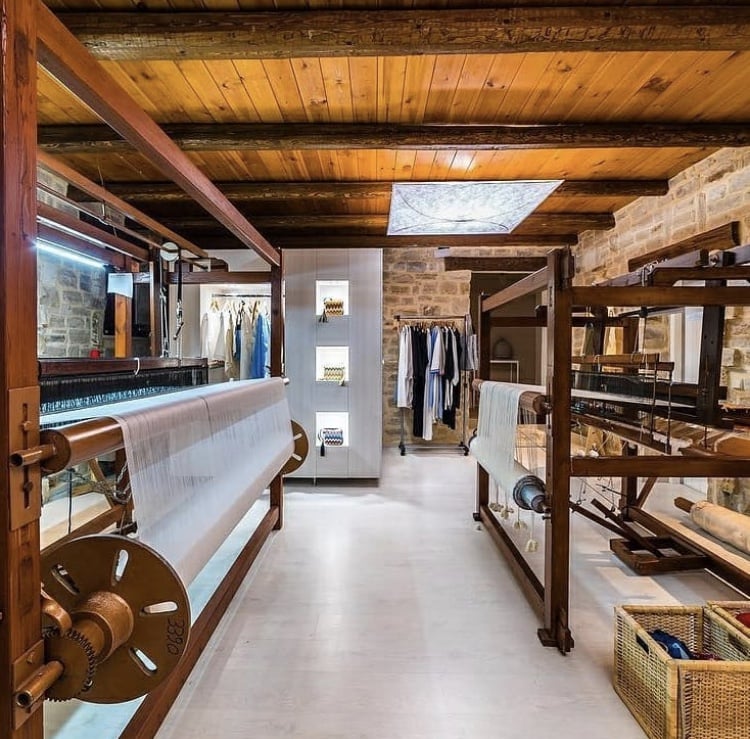Crete, the largest of the Greek islands, boasts a rich cultural heritage that spans thousands of years. Among its many traditional crafts, loom weaving stands out as a particularly vibrant and enduring art form. Cretan traditional loom weaving is more than just a method of creating textiles; it is a profound expression of the island’s history, culture, and identity. Passed down through generations, this intricate craft reflects the skill, creativity, and resilience of the Cretan people.
Historical Roots of Cretan Loom Weaving
The art of loom weaving in Crete dates back to ancient times, with evidence suggesting that the Minoans, one of Europe’s earliest advanced civilizations, were adept weavers. Archaeological finds, including fragments of textiles and depictions of weaving in ancient frescoes, indicate that this craft was highly developed and valued in Minoan society.
Throughout history, Cretan weaving evolved, influenced by various cultures that left their mark on the island, including the Byzantines, Venetians, and Ottomans. Each era contributed new techniques, patterns, and materials, enriching the island’s weaving traditions. Despite these influences, Cretan weavers managed to maintain a distinctive style that remains unique to the island.
The Weaving Process
Traditional Cretan loom weaving is a meticulous process that requires both skill and patience. The primary tool is the loom, a device that has changed little over the centuries. In many Cretan villages, one can still find wooden looms that have been passed down through families, each with its own history and character.
The process begins with the preparation of the yarn. Traditionally, wool from local sheep was the primary material, though cotton and silk are also used. The wool is cleaned, carded, and spun into yarn, which is then dyed using natural dyes derived from plants and minerals found on the island. These dyes produce a range of vibrant colors, from deep reds and blues to rich yellows and greens.
Once the yarn is ready, the weaver sets up the loom, a task that involves stretching the warp threads (the vertical threads) across the loom. The weft threads (the horizontal threads) are then woven through the warp using a shuttle. This process creates the fabric, with patterns emerging as the weaver skillfully manipulates the threads.
Patterns and Designs
Cretan weavers are known for their intricate patterns and designs, which often hold symbolic meanings and tell stories of the island’s history and culture. Common motifs include geometric shapes, floral patterns, and scenes from everyday life. Each design is meticulously planned and executed, reflecting the weaver’s artistic vision and technical prowess.
One of the most iconic Cretan patterns is the “krossa,” a border design featuring interlocking diamond shapes. This pattern is often found on traditional “riza,” a type of woven blanket or shawl. Another popular motif is the “xylastaro,” a complex geometric design that showcases the weaver’s skill.
These patterns are not only decorative but also carry cultural significance. They often symbolize elements of nature, such as the sun, water, and plants, or depict scenes from Cretan mythology and folklore. Through these designs, weavers tell stories and preserve the island’s cultural heritage.
Cultural Significance
Loom weaving holds a special place in Cretan culture. Historically, it was an essential household skill, with women typically responsible for weaving textiles for their families. These textiles included clothing, blankets, and decorative items, many of which were used in daily life or given as gifts during special occasions.
Weaving was also a communal activity, with women often gathering to weave, share stories, and pass on their knowledge to younger generations. This communal aspect fostered a sense of solidarity and continuity within Cretan communities.
Today, loom weaving remains a cherished tradition, celebrated for its artistic and cultural value. In many Cretan villages, weaving cooperatives and cultural associations work to preserve and promote this craft. They organize workshops, exhibitions, and festivals, showcasing the beauty and skill of Cretan weaving to a broader audience.
The Future of Cretan Weaving
In recent years, there has been a resurgence of interest in traditional crafts, including loom weaving. This revival is driven by a growing appreciation for handmade, sustainable products and a desire to reconnect with cultural roots. Young artisans are learning the craft, blending traditional techniques with contemporary designs to create unique textiles that appeal to modern tastes.
This renewed interest offers hope for the future of Cretan weaving. By supporting local artisans and valuing the rich heritage of loom weaving, both locals and visitors can help ensure that this ancient craft continues to thrive for generations to come.
Conclusion
Cretan traditional loom weaving is a testament to the island’s rich cultural heritage and the enduring skill of its artisans. Through intricate patterns and meticulous craftsmanship, Cretan weavers create textiles that are not only beautiful but also imbued with cultural significance. As this ancient craft experiences a revival, it continues to connect the past with the present, weaving a tapestry of history, tradition, and artistic expression that is uniquely Cretan.


